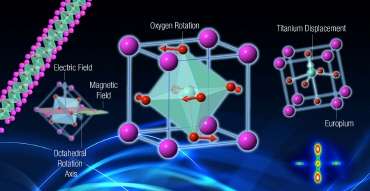Teasing out the nature of structural instabilities in ceramic compounds

(Phys.org) —Materials scientists have been for some time preparing artificial ceramic systems that simply do not exist in nature, allowing scientists to engineer particularly interesting and even technologically applicable behaviors. But sometimes nature itself finds ingenious solutions to physical problems that we have not been able to solve.
An international team of researchers lead by Argonne National Laboratory utilized high-brightness x-rays from the U.S. Department of Energy Office of Science's Advanced Photon Source at Argonne National Laboratory, as well as the European Synchrotron Radiation Facility (ESRF), to study the rare-earth magnetic material europium titanate (EuTiO3). Their results were published in the journal Physical Review Letters.
In a magnetic field, the (near) optical properties of EuTiO3 change quite dramatically, presenting hope of a strong magneto-electric material often dreamed of by engineers for use in combining magnetic and charge parameters for many memory, processing, and sensor devices.
Emerging ceramic materials are displaying a tantalizing array of characteristics that could find application in existing and new technologies including magnetic, piezoelectric, ferroelectric, metal insulator transitions, and even superconductivity. Most interesting to physicists is the delicate nature balancing the underlying parameters that drive each quality. If one introduces a different mix of materials, perhaps replacing one element with another or even slightly distorting the structure, then one parameter disappears while another emerges. How all the separate electronic orbits behave and interact with respect to, and with, each other is a fascinating arena for scientists seeking to understand ceramics, a well-known and ancient material family.
A small subgroup referred to as the "tetravalent titanium pseudo-perovskites" have a particularly interesting and well known characteristic. Typically, they fall into either ferroelectric (a permanent electric polarization by application of an electric field) or paraelectric (a temporary electric polarization via an electric field) categories. This division is driven by two prominent phonon instabilities, which generally compete to dominate the materials structure and thus its electric behavior.
Some of the more ubiquitous members of this family include strontium titanate (SrTiO3), calcium titanate (CaTiO3), lead titanate (PbTiO3), and barium titanate (BaTiO3). The first two (SrTiO3 and CaTiO3) are very common and prototypical of the perovskite structure. Both of these systems experience a structural response whereby the oxygen cage tilts and or rotates within the cubic unit cell.
On the other hand, the latter two examples (PbTiO3) and BaTiO3) do not exhibit oxygen distortion but rather the central atom, the titanium, moves away from the center of the sample unit cell. This shift generates a non-neutral electric polarity and with it an internal electric field. Moreover, by applying an electric field, all the titanium atoms can be switched across the center, changing the direction of the polarity and making it a true ferroelectric material.
The researchers in this study, from Argonne, the University of Liverpool (England), the ESRF (France), Universidad de Castilla-la Mancha (Spain), and the Swiss Federal Laboratories for Materials Science and Technology studied a less common member of the same family, europium titanate (EuTiO3). This rare-earth magnetic version has the additional oddity that it demonstrates an anomalous magneto-dielectric character: In a magnetic field, the (near) optical properties change quite dramatically. This presented hope of a strong magneto-electric material often dreamed of by engineers for use in combining magnetic and charge parameters for many memory, processing, and sensor devices.
"What we know is that ferroelectricity is a very useful commodity, and that the oxygen octahedral rotations can inhibit the potential to generate ferroelectricity," said Jong-Woo Kim, a co-author on this study.
The question is, how do these structural instabilities interact and through what mechanism are they coupled?
What surprised the team was evidence of both an oxygen cage structural distortion and a titanium displacement coexisting. What they found was a scenario whereby the two instabilities were well balanced and the system as a whole didn't reconcile a preferred state.
"The result of a complicated superstructure allowing both parameters—in a sense, inter-digitized and therefore spatially separated—resolves the issue of how the competing mechanisms exist in one structure," said article co-author Philip Ryan.
Ultimately, the team demonstrated that, with coupled electric and magnetic field application one could monitor the structural response of the oxygen cage rotation, suggesting that the oxygen ion itself plays a role in mediating the magnetism of the europium ions and the electric parameter of the titanium ions and is not, as previously thought, a passive player in the magneto-dielectric phenomenon.
More information: Jong-Woo Kim, Paul Thompson, Simon Brown, Peter S. Normile, John A. Schlueter, Andrey Shkabko, Anke Weidenkaff, and Philip J. Ryan, "Emergent Superstructural Dynamic Order due to Competing Antiferroelectric and Antiferrodistortive Instabilities in Bulk EuTiO3" Phys, Rev. Lett. 110, 027201 (2013). DOI:10.1103/PhysRevLett.110.027201
Journal information: Physical Review Letters
Provided by Argonne National Laboratory





















